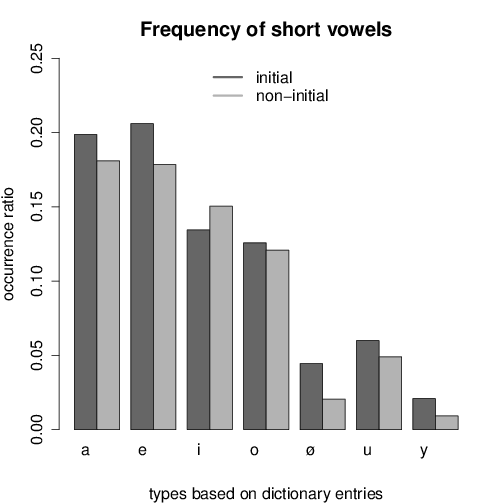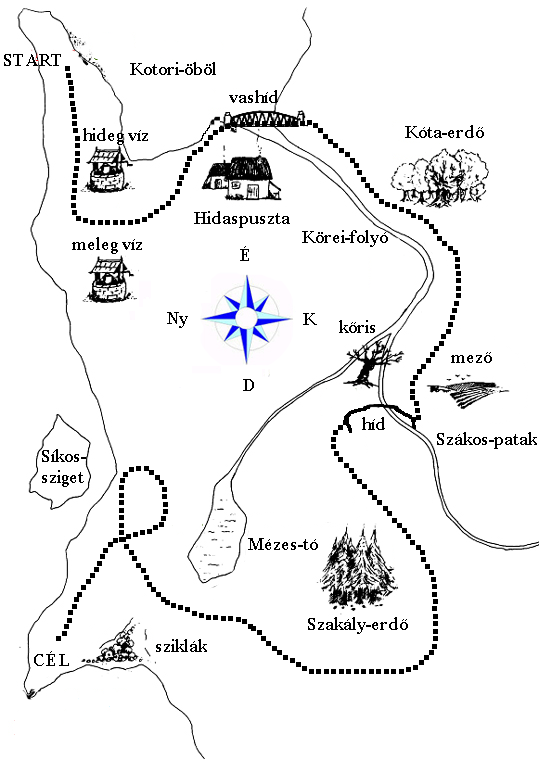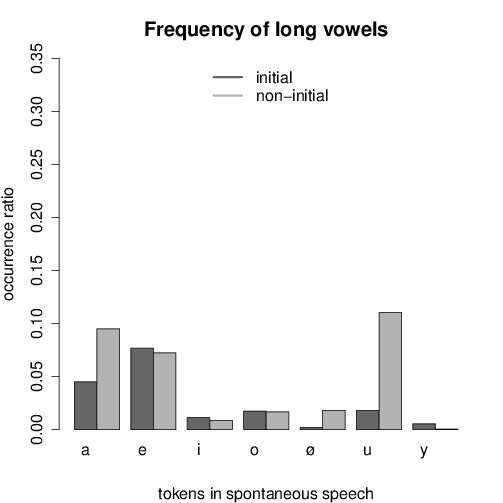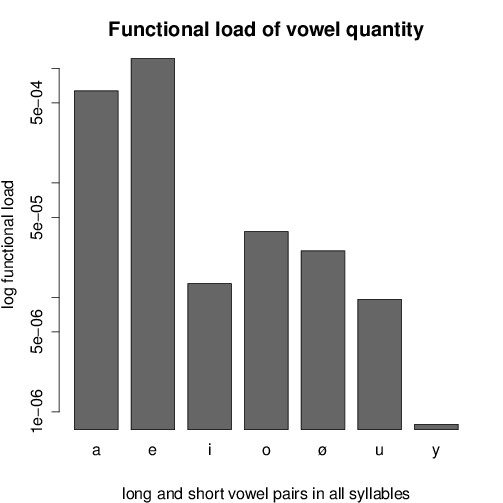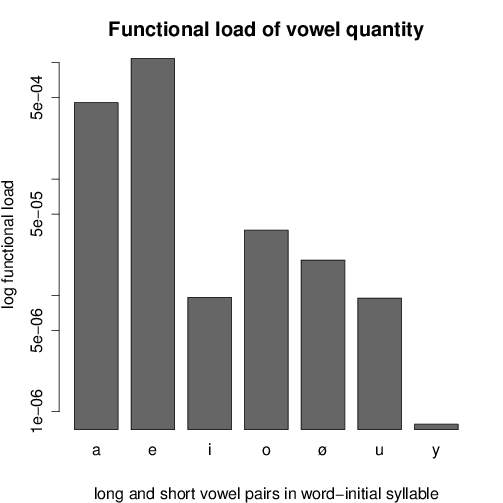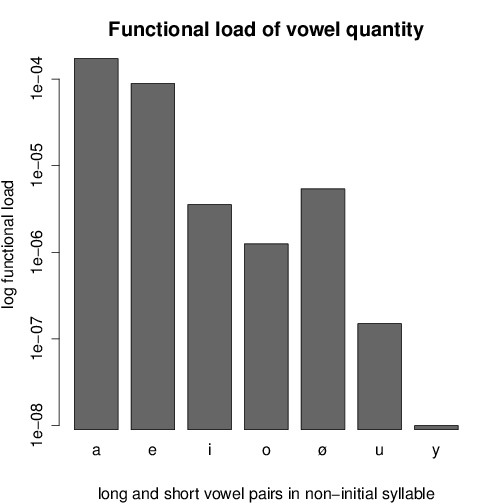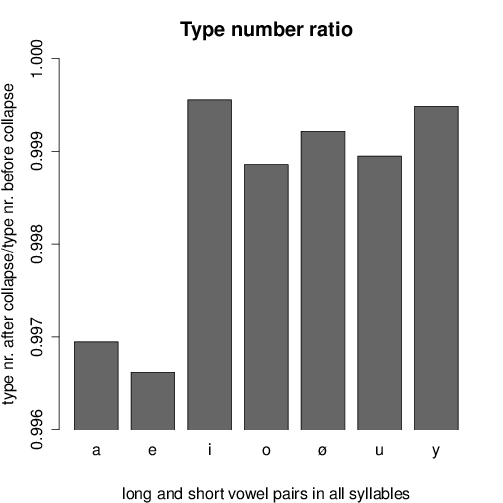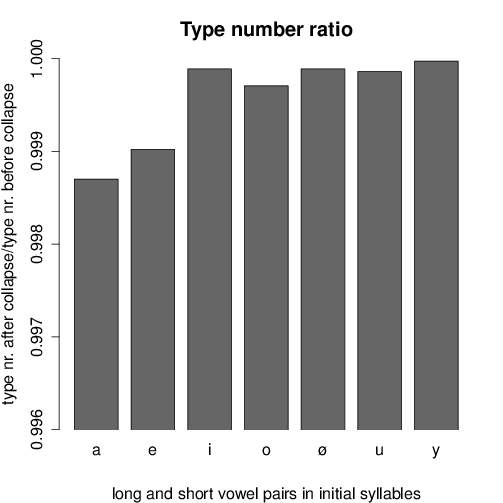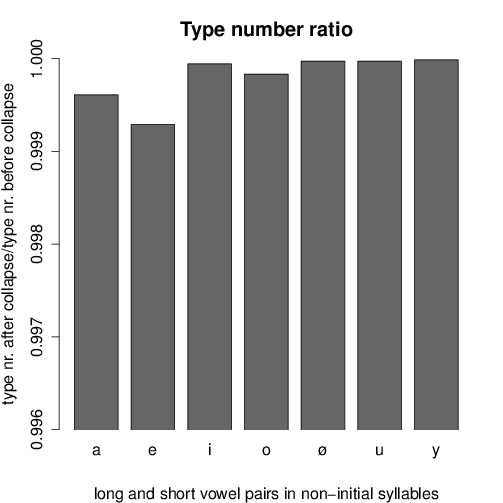Analogy by frequency: a possible reason for the
vowel length neutralisation process?
Katalin Mády & Uwe D. Reichel
Institute for Linguistics, Hungarian Academy of Sciences
1 The Hungarian vowel system
Hungarian has traditionally been described as a language with a phonological
quantity distinction for both vowels and consonants. While the relevance of this
feature for consonants has been questioned by Siptár (1995) based on the very
small number of minimal pairs and their restricted distribution, the quantity
distinction for vowels is unquestionably a relevant feature according to both
phonetic and phonological descriptions. The vowels i-í ü-ű u-ú o-ó ö-ő,
where the accent sign marks long quantity, not stress, correspond to the
vowel qualities /i-i: y-y: u-u: o-o: ø-ø:/ and are accounted for as five pairs
distinguished primarily by their length. The remaining vowels, a-á and e-é, are
classified in a different manner in form-oriented (phonetic) and function-oriented
(phonological) frameworks. Phonetic descriptions take into account that these
vowels do not only differ by quantity, but also by their quality, the latter
being the primary cue. Short a is sometimes described as a back, mid-low,
rounded vowel /ɔ/, while long á is produced as central, low, and unrounded
/a:/. In Mády (2008) it was argued that vowel height is not necessarily
distinctive between a and á, since the somewhat smaller jaw opening of a can be
explained by the fact that the vowel is rounded: Hungarian /y/ was also
produced with a smaller jaw opening than its unrounded equivalent /i/ in this
articulography study. Nevertheless, the a vowels /ɒ/ and /a:/ are obviously
distinguished by at least one quality feature beside quantity. The same is true
for e and é, of which the short vowel is a mid-low front unrounded /ɛ/,
and the long one is a mid-high front unrounded /e:/. The vowel system of
Standard Hungarian does not contain any other vowels such as reduced ones or
diphthongs.
Phonologists, on the other hand, encounter phonological processes in which /ɒ/
alternates with /a:/ and /ɛ/ with /e:/ in exactly the same way as short and long mid
and high vowels do. One such rule is Final Stem Vowel Shortening: in certain
stems, a long vowel is replaced by its short counterpart if a given suffix is
added to the stem, e.g. kút /ku:t/ ‘well’ – kutak /kutɒk/ ‘wells’, kéz /ke:z/
‘hand’ – kezel /kɛzɛl/ ‘to handle’, sár /ʃa:r/ ‘mud’ – sarat /sɒrɒt/ ‘mud
+ acc.)’. Another example is Internal Stem Vowel Shortening that is
triggered by certain suffixes such as -ál, -ikus etc., e.g. aktív /ɒkti:v/ ‘active’
– aktivál /ɒktiva:l/ ‘to activate’, kultúra /kultu:rɒ/ ‘culture’ – kulturális
/kultura:liʃ/ ‘cultural’. (See Siptár & Törkenczy 2000: 58–62 for a detailed
description of these rules.) In this paper we will accept the assumption that the
vowels /ɒ/-/a:/ and /ɛ/-/e:/ are vowel pairs with quantity as a distinctive
feature, regardless of their different qualities, for reasons to be explained
below.
Vowel length in Hungarian is encoded by orthography: long vowels are marked by
an accent, short vowels by the absence of it (e.g. ó-o,  -ö for /o/ and /ø/, the
umlaut marking front rounded vowels). This has two consequences: first, native
Hungarian speakers are aware of vowel quantity, unlike e.g. German or Swedish
speakers, second, the pronunciation norm is conserved by orthography to some
extent.
-ö for /o/ and /ø/, the
umlaut marking front rounded vowels). This has two consequences: first, native
Hungarian speakers are aware of vowel quantity, unlike e.g. German or Swedish
speakers, second, the pronunciation norm is conserved by orthography to some
extent.
Given this, it might appear surprising that quantity is not consequently realised
in the way orthography would suggest. For example, the compound word kórház
‘hospital’ is often produced as /korha:z/, i.e. with a short /o/, in Educated
Colloquial Hungarian (a variety widely accepted all over the country), although the
lexemes kór ‘disease’ and ház ‘house’ are both pronounced with long vowels. This
discrepancy between orthography and the usual pronunciation of a word does not
involve mid vowels very often, but it is frequent for the high vowels u, y, and i. While
there are some examples where an orthographically short vowel is produced as a long
one in colloquial speech (such as dicsér ‘to praise’ that is pronounced as /di:tʃe:r/ by
many speakers), the vast majority of the discrepancies involves cases in which long
graphemes are produced as short vowels (e.g. címke /tsimkɛ/ ‘label’). The
shortening tendency is even more advanced in unstressed syllables. Siptár
& Törkenczy (2000) claim that the quantity distinction for high vowels is
missing completely in word-final position, at least in Educated Colloquial
Hungarian.
In this paper, the relevance of the distribution of short and long vowels is
investigated, with a special focus on syllables carrying more or less prominence.
Hungarian has fixed lexical stress that is always word-initial. Syllables with lexical
stress are potential carriers of sentence-level pitch accents. Thus, the distribution of
short and long vowels in these syllables might have a different impact on the
preservation of the vowel quantity distinction.
First, a short diachronic overview of quantity variation in dialects is given.
Subsequently, frequency of short and long vowels in a type and a token word list is
analysed. Furthermore, we investigate a potential interplay between the functional
load of a quantity opposition and its preservation.
2 Dialectal variation
There is considerable variation in the distribution of high short and long vowels
accross the regional varieties of Hungarian. In large parts of Western Hungary, the
vowel system does not contain long high vowels at all (Kálmán 1989). On the
other hand, a prevalence of long high vowels can be observed in the Eastern
Hungarian dialects, in which many short vowels of the standard variety are
lengthened, especially in stressed (i.e. word-initial) syllables. According to
Benkő (1957), short vowel lengthening in the Eastern dialects took place
from the 16th century on, and the development to shorten long vowels in
the Western regions is at least as this old. He explains the unstability of
these vowels by the process of the Final Stem Vowel Shortening (see above):
while in the Eastern dialects the shortening rule often failed to apply to
suffixed stems and resulted in a higher number of long vowels, the Western
region shortened vowels in unsuffixed stems analogously to their suffixed
forms as opposed to Central Hungarian dialects on which today’s standard
is based. (E.g. Eastern út ‘road’, útazik ‘to travel’, as opposed to Central
utazik ‘to travel, Western viz ‘water’, vizes ‘wet’ as opposed to Central
víz.)
Another change in vowel quantity was the shortening of word-final long
/u:/ and /y:/ that included large regions both in West and East (in the
West it also applied to /i:/). Since word-final vowels in polysyllabic words
are always unstressed in Hungarian, Benkő suggests that the shortening
process is due to the missing prominence in these syllables. Although the same
process did not take place in Central Hungary, it is remarkable that vowel
shortening in unstressed syllables has become part of today’s Colloquial
Educated Hungarian that is also spoken in the Central Hungarian capital
Budapest.
According to Benkő, the quantity change in stressed syllables was triggered by
the coexistence of the stems with long and short word-final vowels in their unsuffixed
and suffixed forms. However, as described above, this rule is not restricted to high
vowels, on the contrary, it mostly applies to stems with low vowels (for an exhaustive
list, see Siptár 2003: 311). On the other hand, the few stems that include word-final
mid vowels are special: in course of the shortening process, a /v/ is inserted
after the vowel, e.g. ló ‘hourse’ vs. lovak ‘hourses’. Thus, the systematic
shortening of stem vowels alone cannot account for the variable quantity of high
vowels.
3 Distribution of short and long vowels
3.1 Frequency in types
Another potential reason for the shortening of long high vowels could be their lower
frequency in the language. According to Gósy (2004): 85ff., long vowels are far less
frequent in Hungarian, than short ones. In her statistics, the proportion of long
vowels was given with 21% among all vowels, long y: being the most unfrequent
one.
A further question is whether the distribution of long and short vowels is identical
across word-initial (= stressed and potentially accented) and non-initial syllables. A
lower occurrence of long vowels in non-initial syllables could explain the shortening
tendency based on analogy.
Type analysis was performed on a word list consisting of 29 245 lemmas based on
the lexical entries in the Magyar értelmez kéziszótár. The list word stems (such as
asztal ‘table’) and derived forms (such as asztalos ‘carpenter’), but no words with
inflectional suffixes such as plural forms, since the latter were not given as lexicon
entries.
kéziszótár. The list word stems (such as
asztal ‘table’) and derived forms (such as asztalos ‘carpenter’), but no words with
inflectional suffixes such as plural forms, since the latter were not given as lexicon
entries.
Table 1: Frequency of vowels in lexicon entries in the Magyar értelmező
Kéziszótár.
| vowel | word-inital syllable | non-initial syllable | sum |
|
|
|
|
| a | 5804 | 10130 | 15934 |
|
|
|
|
| á | 2121 | 6387 | 8508 |
|
|
|
|
| e | 6016 | 9990 | 16006 |
|
|
|
|
| é | 1823 | 3554 | 5377 |
|
|
|
|
| i | 3926 | 8420 | 12346 |
|
|
|
|
| í | 532 | 1188 | 1720 |
|
|
|
|
| o | 3673 | 6766 | 10439 |
|
|
|
|
| ó | 686 | 2938 | 3624 |
|
|
|
|
| ö | 1295 | 1143 | 2438 |
|
|
|
|
| ő | 339 | 1382 | 1721 |
|
|
|
|
| u | 1749 | 2742 | 4491 |
|
|
|
|
| ú | 417 | 484 | 901 |
|
|
|
|
| ü | 610 | 512 | 1122 |
|
|
|
|
| ű | 221 | 350 | 571 |
|
|
|
|
| |
Frequency counts for vowels are given in Table 1. Since there is no general
agreement on the corresponding IPA symbols in the literature, orthographic symbols
are used.
Figures 1 and 2 show the frequency of short and long vowels in the dataset,
consisting of 85 198 vowels altogether, 29 212 of which occurred in the first syllable
of the word (34%). The amount of short vowels was 62 776 (74%).
Since the proportion of non-initial syllable positions was substantially higher, the
ratios given in the figures were calculated based on the overall count of vowels in
word-initial vs. non-initial syllables: e.g. the absolute frequency of short /o/ in the
word-initial syllable was divided by the number of all vowels in the same
position.
The amount of short vowels in word-initial syllable position was higher than in
non-initial syllables, except for /i/. At the same time, long vowels occurred more
often in non-initial syllables in most vowel pairs. A possible reason for this could be
the fact that certain derivational suffixes with high frequency contain long vowels,
such as -ás/-és, -ság/-ség.
Interestingly, vowel frequency does pattern along with the three categories high,
mid, and low. Short /ɛ/ is the most frequent vowel closely followed by short /ɒ/, and
also their long equivalents are more frequent than the other five vowels. The low
frequency of the other high vowels /u y/ is in line with the analogy hypothesis. On
the other hand, the frequency of long /i:/ is almost identical with that of long /ø:/,
while only /i/ is involved in the shortening process described in the literature. Thus,
the tendency observed in the type-based word list does not support the analogy
hypothesis.
3.2 Frequency in tokens
Type frequency by itself is not necessarily informative on the actual occurrence of
long vowels in spoken language for various reasons. First, token frequency is not
taken into account. Second, inflexional suffixes that do not occur in the
list of lexical entries discussed above contain more often short vowels in
Hungarian, than long vowels. Third, the frequency of certain types in colloquial
speech can substantially differ from the word list discussed in the previous
section.
For this reason, spoken language data from a maptask corpus was used to analyse
the distribution of short and long vowels in spontaneous speech. The corpus contains
data from 27 speakers between 18 and 63 years, including 13 female and 14 male
speakers. Dialectal background and social status of speakers differed (see Mády 2010a
for more detail).
The database was created for the acoustic analysis of short and long vowels in
identical consonantal environments. On the map of the first speaker, a path objects is
marked. The first speaker is supposed to guide the second speaker along this path
that is not visible for the second speaker. However, as can bee seen in Figure 3, the
two maps were not completely identical. The maps used for this specific task are
shown in Figure 3.
The overall length of the speech material was 115 minutes. Recordings were
transcribed into their orthographic form, i.e. according to the grapheme system of
Hungarian (not IPA or other phonetic symbols). The material was segmented into
word forms. Unfinished forms due to interruption were removed from the list. Since
target words were partly invented geographical names such as Szákos-patak referring
to a stream that are not part of everyday language usage, proper names were not
taken into account for further analysis.
One of the questions of this paper is whether the frequency of short and long
vowels located in potentially prominent (i.e. pitch-accented) syllables is identical.
However, not every word can carry a pitch accent. Therefore definit and
indefinit articles such as a ‘the’, non-accentable conjunctions such as és, ha
‘and’, ‘if’ and modal particles such as hát ‘well’ were excluded from the
analysis. Admittedly, this procedure is blind for the presence of pitch accents on
these words. For example, the indefinit article egy ‘a’ is homophonous with
the numeral egy ‘one’, and the latter usually carries a pitch accent. Since
manual checking of the accent patterns was not possible in this case, all
tokens of this type were disregarded. Other words that can function both
as a content or a function word, e.g. fog ‘grab’ or a future auxilary, were
regarded as potential prominence carrier units and were included in the
analysis.
The dataset contained 17 916 vowels, 9024 were located in word-initial syllables
(50%), and 13 475 were short ones (75%). The high proportion of vowels in
word-initial syllables is due to the overall high occurrence of monosyllabic words such
as verbal prefixes.
The distribution of short vowels is partly different from frequencies in the word
list. Here, ɛ is by large the most frequent vowel. This is in line with the wide-spread
assumption that this sound is the most frequent one in Hungarian, but differs from
frequency data based on the lexicon entries where /ɒ/ was only slightly less frequent
than /ɛ/. It is interesting that /i/ is extremely unfrequent in non-initial
syllables.
The relative frequencies of long vowels show a similar pattern to type frequencies,
with the exception of /u:/.
The distributional data do not favour the hypothesis that the small number of
long high vowels could be responsible for the preference for short high vowels.
First, /i:/ is not less frequent than /ø:/. Second, not only high, but all long
vowels are less frequent both in stressed and unstressed position than short
ones.
4 Functional load of quantity oppositions
Next to the vowel frequency analyses we investigated whether the functional load of a
quantity opposition could be accounted for its preservation. We hypothesise that
oppositions with a high load are more stable than oppositions for which the load is
low. The importance of a quantity opposition is quantified by two measures described
in the following.
4.1 Functional load
The functional load FL of a phonological opposition of the phonemes a and b is
related to the number of contrasts this opposition is responsible for in a language L.
The information theoretic definition adopted here was first introduced in
(Hocket 1967):
H(L) is the entropy of a language L. La=b denotes a language lacking
an opposition of a and b. FL(a,b) thus stands for the relative amount of
information loss resulting from such a merging, reflecting the increase of
homophones.
L and La=b are the sets of word types w of the Magyar értelmező kéziszótár
before and after vowel merging, respectively, which was done separately for each
vowel quantity pair. From the word type frequencies contained in this dictionary
maximum likelihood probabilities were calculated in order to derive the entropies for
L and La=b as follows:
The frequencies for merged types in La=b were simply obtained by summing up
the frequencies of all types of L undergoing this merging after the loss of the
opposition of a and b.
4.2 Type number ratio
Since the FL is calculated over the entire lexicon it does not normalise for
vowel-related frequencies, that in turn determine the number of resulting
homophones after quantity merging. FL is positively correlated with vowel frequency,
since the merging of frequent vowels results in more homophones so that their
quantity opposition receives a high functional load.
In order to reduce this frequency bias, we additionally calculated the ratio of
those types only, that are affected by a vowel quantity merging. As an example, for
the merging of /u:/ we considered only those words that contain the letter u and/or ú. For these types we derived the ratio Na∕Nb, where Nb denotes the
number of types before merging and Na denotes the number of types after
merging.
4.3 Word stress
In order to test the impact of word stress on quantity merging, we applied the two
measures for three different vowel merging scenarios: (1) in all syllables, (2) in the
word-stressed (initial) syllable only, and (3) in all non-stressed (non-initial) syllables
only.
4.4 Results
The functional loads and type number ratios for each vowel pairing are shown in
Figures 6 and 7, respectively. Important oppositions are indicated by a high
functional load and a low type number ratio.
Based on Figure 6 for the impact of functional load on quantity preservation the
following conclusions can be drawn:
- The quantity oppositions for /e, a/ have the highest functional loads,
which – in line with our hypothesis – prevents them to undergo quantity
merging. This merging would result in a significant decrease in lexical
contrasts and therefore an increase in ambiguity.
- Over the entire word /i, u, y/ quantity oppositions have the lowest
functional loads. Thus it is not this crucial to maintain these oppositions,
and indeed, these vowels are least stable in preserving them.
- Also word-initially the functional loads of /i, u, y/ quantity oppositions
are the lowest, so that the absence of these oppositions e.g. in Western
Hungarian is not harmful.
- However, in non-initial syllables also the quantity opposition for /ø/ has a
low functional load, but against the expectation for this vowel the quantity
opposition is maintained.
For the type number ratios shown in Figure 7 we obtained the same
tendencies.
- For /a, e/ the lowest ratios have been measured, again well explaining the
stability of their quantity contrasts in order not to drastically increase the
number of homophones.
- /i, u, y/ show high ratios, especially in non-initial syllables, indicating
only a negligible increase of ambiguity in case of quantity merging.
- However, high ratios are given also for /o, ø/.
5 Discussion and conclusions
Vowel statistics did not turn out to play a crucial role in explaining varying degrees
of stability of quantity oppositions. The functional load of an opposition, however,
has been found to have an impact on maintaining quantity contrasts. A high
functional load is a sufficient motivation to maintain such contrasts. The reverse, that
a low functional load leads to quantity merging, holds for high, but not yet for mid
vowels.
The quantity opposition in mid vowels might be subject to an ongoing sound
change process at present. Perception experiments in Mády (2010b) and
Mády (2012) show that the perceptual boundary between long and short /o/ in
word-final position is shifted towards the short vowel in young participants compared
to the older group. They heard both shorter and more centralised /o/ segments as
long vowels, whereas a segment had to be longer and more centralised to be idenfified
as a long /o:/ by listeners above 50 years. Thus, the quantity distinction might
become less stable also for mid vowels at some point. This development would
again be well explainable by the low functional load of mid-vowel quantity
oppositions.
6 Acknowledgements
Data for the maptask corpus were recorded at the Laboratory of Speech Acoustics at
the Technical University of Budapest. We highly appreciate the help of Klára Vicsi
and her colleagues.
References
Benkő, L. (1957), Magyar nyelvjárástörténet, Egyetemi magyar
nyelvészeti füzetek, Tankönyvkiadó Vállalat.
Gósy, M. (2004), Fonetika, a beszéd tudománya, Osiris Kiadó, Budapest.
Hocket, C. (1967), ‘The quantification of functional load’, Word
23, 320–339.
Kálmán, B. (1989), Nyelvjárásaink, 5. kiadás, Tankönyvkiadó, Budapest.
Mády, K. (2008), ‘Magyar magánhangzók vizsgálata elektromágneses
artikulográffal gyors és lassú beszédben’, Beszédkutatás pp. 52–66. [An
EMA investigation of Hungarian vowels in normal and fast speech].
Mády, K. (2010a), ‘Hungarian vowel quantity neutralisation as a potential
social marker’, Acta Linguistica Hungarica 57(2–3), 167–188.
Mády, K. (2010b), Shortening of long high vowels in Hungarian: a
perceptual loss?, in ‘Proc. Sociophonetics at the crossroads of speech
variation, processing and communication’, Pisa, Italy, pp. 41–44.
Mády, K. (2012), Implicit and explicit language attitude in a sound change
process, in ‘Proc. 2nd Sound Change Conference’, Kloster Seeon, Germany,
p. 87.
Siptár, P. (1995), A magyar mássalhangzók fonológiája, Linguistica, Series
A: Studia et Dissertationes 18, MTA Nyelvtudományi Intézet, Budapest.
[The phonology of Hungarian consonants].
Siptár, P. (2003), Hangtan [phonology], in ‘Új magyar nyelvtan [New
Hungarian grammar’, Osiris, Budapest.
Siptár, P. & Törkenczy, M. (2000), The Phonology of Hungarian,
University Press, Oxford.
 -ö for /o/ and /ø/, the
umlaut marking front rounded vowels). This has two consequences: first, native
Hungarian speakers are aware of vowel quantity, unlike e.g. German or Swedish
speakers, second, the pronunciation norm is conserved by orthography to some
extent.
-ö for /o/ and /ø/, the
umlaut marking front rounded vowels). This has two consequences: first, native
Hungarian speakers are aware of vowel quantity, unlike e.g. German or Swedish
speakers, second, the pronunciation norm is conserved by orthography to some
extent.

